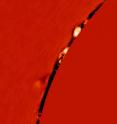STEREO, SOHO spacecraft catch comet diving into sun
Related images
(click to enlarge)
Solar physicists at the University of California, Berkeley, have captured for the first time the collision of a comet with the sun. Using instruments aboard NASA's twin STEREO spacecraft, four post-doctoral fellows at UC Berkeley's Space Sciences Laboratory were able to track the comet as it approached the sun and estimate an approximate time and place of impact. STEREO (Solar TErrestrial RElations Observatory), launched in 2006, consists of identical spacecraft orbiting the sun, one ahead of Earth and one behind Earth, providing a stereo view of the sun.
The researchers then looked at data from the ground-based Mauna Loa Solar Observatory in Hawaii, and found images in the predicted spot of what appears to be a comet approaching the edge of the sun from behind the solar disk.
"We believe this is the first time a comet has been tracked in 3-D space this low down in the solar corona," said Claire Raftery, a post-doctoral fellow newly arrived at UC Berkeley from Dublin's Trinity College.
The team will present its data and images during a 5:30-6:30 p.m. poster session on Monday, May 24, at the Miami, Fla., meeting of the American Astronomical Society.
Sungrazing comets, comprised of dust, rock and ice, are seldom tracked close to the sun because their brightness is overwhelmed by the solar disk. This comet apparently survived the heat of the corona and disappeared in the chromosphere, evaporating in the 100,000-degree (Kelvin) heat.
Raftery and her colleagues, Juan Carlos Martinez-Oliveros, Samuel Krucker and Pascal Saint-Hilaire, concluded that the comet was probably one of the Kreutz family of comets, a swarm of Trojan or Greek comets ejected from their orbit in 2004 by Jupiter, and that it made its first and only loop around the sun. The swarm probably resulted from the disintegration of a larger comet.
Martinez-Oliveros' attention was first drawn to the comet after seeing it mentioned in a summary of March 12, 2010, observations by STEREO and by SOHO, the Solar and Heliospheric Observatory. The comet's long, bright tail of dust and ions tagged it as a sungrazing comet seen often by solar astronomers and observatories such as STEREO.
Assuming it was a going to loop around the sun, the researchers decided to see whether the STEREO data were good enough to let them calculate its trajectory.
In fact, the data were good enough to chart the comet's approach for two days before impact.
With an estimate of the impact zone within a circle about 1,000 kilometers in diameter, they searched online data from the Mauna Loa Solar Observatory to determine if they could see the comet next to the sun's edge in the ultraviolet region of the spectrum.
They found a short track, lasting about six minutes, just a few thousand kilometers above the sun's surface in the million-degree corona and 100,000-degree chromosphere.
Based on the comet's relatively short tail, about 3 million kilometers in length, the researchers believe that the comet contained heavier elements that do not evaporate readily. This would also explain how it penetrated so deeply into the chromosphere, surviving the strong solar wind as well as the extreme temperatures, before evaporating.
For their study, the team used the two coronagraphs on STEREO A and B and multiple instruments on SOHO, "demonstrat(ing) the importance of multi-view observations of non solar phenomena," they wrote in their poster.
All members of the team study explosive events on the sun, such as coronal mass ejections, and the hot ionized plasmas that they throw into space. The researchers' detour into cometary physics was purely accidental, they said.
"It was supposed to be an exercise, but it took over our lives," Raftery said.
Source: University of California - Berkeley
Articles on the same topic
- Post-mortem of a cometFri, 28 May 2010, 15:15:52 UTC
Other sources
- Post-mortem of a Comet: Scientists put the Comet Wild 2 under the microscopefrom PhysorgFri, 28 May 2010, 13:41:10 UTC
- New action film set in solar system's centerfrom Sciencenews.orgTue, 25 May 2010, 15:50:24 UTC
- Comet dives into Sun: STEREO, SOHO spacecraft catch crashfrom Science DailyTue, 25 May 2010, 3:20:48 UTC
- STEREO, SOHO spacecraft catch comet diving into sunfrom Science BlogTue, 25 May 2010, 0:20:38 UTC
- STEREO, SOHO spacecraft catch comet diving into sun (w/ Video)from PhysorgMon, 24 May 2010, 22:50:21 UTC
- STEREO, SOHO spacecraft catch comet diving into sunfrom Science BlogMon, 24 May 2010, 22:20:19 UTC
- Comet's Collision with the Sun Captured in 3-Dfrom Space.comMon, 24 May 2010, 21:50:21 UTC
